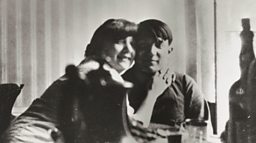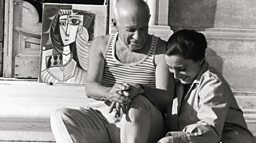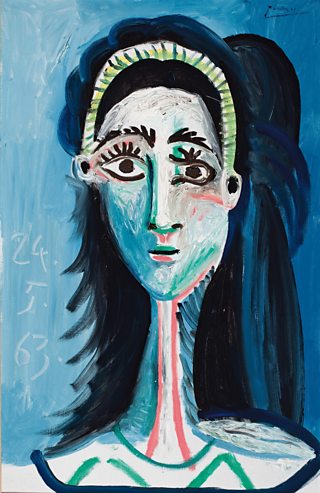Picasso's ex-factor: The six women who shaped his life and work
22 September 2023
When Pablo Picasso changed the women in his life, he changed everything from his house and friends to even his pets. That’s according to the artist Dora Maar, who is one of six women whose turbulent long-term relationships with him are explored in Picasso: The Beauty and the Beast, a new three-part 大象传媒 documentary series. Here is a look at the women whose lives were forever changed by Picasso.


Fernande Olivier

Born in 1881, the same year as Picasso, Fernande was a French artist and model who began a relationship with him in 1904.
Around the same time, Picasso began his Rose Period where his paintings were characterised by upbeat red, orange and pink colours in contrast to the melancholy tones of his Blue Period.
According to New Yorker writer Alexandra Schwartz, Fernande was his “first great love”. “The Rose Period is marked by the rose colours but also the most joyous experience of life, and I think it's greatly due to Fernande,” she tells the programme.
Fernande would later say that Picasso continued to be driven by great ambition and “wanted to create a new kind of art”. When he entered his next great artistic phase, she featured repeatedly as a model and as a muse in his Cubist paintings.
Picasso’s constant experimentation and development is reflected in his art, according to Schwartz. She says: “He's a restless soul and I think he's that way in his domestic and personal life too. There is this constant strain and there are also affairs. He is not a one-woman kind of guy.”
Their relationship ended in 1912 amid affairs and recriminations, and as their circle of friends sided with Picasso, Fernande was left alone and impoverished.
The story of their relationship is explored in episode one on 大象传媒 iPlayer.


Olga Khokhlova

Picasso’s depictions of his lovers change over the course of their relationships, and this is demonstrated most starkly in his paintings of his first wife Olga.
Gagosian Gallery curator Michael Cary observes in the first episode: “When you look at the portraits of Olga, she starts off as the beautiful wife. By the end of their relationship, she's depicted as a hag and a monster. It's hard to see love in their relationship in the work.”
Ten years younger than Picasso, Olga was a Ukrainian ballet dancer who first met him in 1917 while he worked on designs for the radical ballet Parade, fusing figurative art and extraordinary Cubist costumes. A year later, they married and began life as a fashionable celebrity couple moving in social circles with friends such as Igor Stravinsky, Jean Cocteau and Coco Chanel.
'Restless'
Art critic Louisa Buck says: “Olga appears in Picasso's work to begin with in a very classical way, drawn with meticulous realism. At the same time his Cubism didn't go away, it's just that tended to render Olga in a very naturalistic way, probably to please her, because I think she was quite conventional in terms of the art that she liked.”
Alexandra Schwartz says: “Picasso will get restless, he will seek out other lovers, he will try to push away the women in his life.
“The older he gets, the more explicit he is about his wanting to really mark the lives of his lovers so that in some ways - and this is a horrible idea and a horrible phrase - they will be damaged goods after he leaves them; that the highlight of their lives will have been Picasso.”
Picasso finally split with Olga in 1935 while his young lover, Marie-Thérèse, was pregnant.
Olga's marriage to Picasso features in episode one on 大象传媒 iPlayer.



How Picasso's exes were ever present in his life and art
Picasso's daughter explains why her father never ended his relationships with women.

Marie-Th茅r猫se Walter

In a radio interview many years after Marie-Thérèse first encountered the married artist at the age of 17, she described how he came up to her while she was out shopping.

She said: “He gave me a beautiful smile and then he approached me and said to me, ‘Mademoiselle, you have an interesting face, I would like to do your portrait and I feel that we will do great things together.’ And then he said to me, ‘I am Picasso.’”
In 1932, at the age of 50, Picasso staged his first major career retrospective at the Galeries Georges Petit in Paris. Among the works on show were some of his recent paintings that made it clear he had met a new lover.
According to Gagosian Gallery curator Michael Cary, legend has it that until that moment, Picasso’s wife Olga had no idea that Marie-Thérèse existed.
“She looked around the room and she saw all these beautiful, stunning portraits of this blonde woman on the walls, and that was her discovery of the fact there was another woman in Picasso's life,” he tells the programme.
'Sensuality'
Artist Jenny Saville says: “When he's painting the curvature of Marie-Thérèse’s body, the sensuality of that, I mean, I don't know another artist in our history that has painted desire and sex as beautifully as Picasso.”
By 1935, Marie-Thérèse had given birth to their daughter, and Picasso’s artistic depiction of her is strikingly different.
In Femme Endormie, Picasso’s portrait of Marie-Thérèse, Michael Cary says her look is now “cosy and a bit mumsy”.
“Marie-Thérèse thought having a child together would change their relationship, and it's telegraphed in the work - she becomes less of a sexy character,” he says.
The relationship between Marie-Thérèse Walter and Picasso features in episode two on 大象传媒 iPlayer.

Dora Maar

The French photographer and painter was at the height of her career when she first met Picasso.

Sat at a Parisian café table, she was wearing elegant gloves and flicking a penknife between her splayed fingers.
According to former Tate Modern director Frances Morris, “Every now and again, the penknife would hit the finger and so there was sort of a Jackson Pollock effect of blood spilling out. He introduced himself, asked whether he could have her gloves, and they became part of his memorabilia.”
Her biographer Victoria Combalia says: “Dora was a kind of masochistic personality and Picasso was a kind of sadistic personality who could be cruel; they had this in common, that one needs the other.”
For Christie’s vice-chairman Giovanna Bertazzoni, “She's the ultimate surrealist diva.”
“She enters the scene like a Shakespearian heroine, absolutely full of drama and art and tragedy and power and erotic prowess and he is totally taken aback and that's the beginning of the story,” she says.
Dora’s features are often said to be the basis for Picasso’s 1937 Weeping Woman series of abstract paintings, described by MoMA curator Anne Umland as “these heart-wrenching responses to world circumstances”.
According to Picasso family friend Antony Penrose, “It's unfair in a way to Dora because it gave her the sobriquet of being a woman who wept and people thought that she was just a miserable character who was always blubbing when she wasn't.”
'Extraordinary career'
In 1937, Picasso also painted Guernica, one of his greatest works, and Dora was in the studio every day to document every stage of its progress. In the following period, their relationship began to deteriorate.
When World War Two broke out, the Nazi occupation of Paris made life difficult for them, and the death of Dora’s mother also contributed to her mental health difficulties.
“Dora Maar wanted desperately to be with him but Picasso cut her off completely,” says Victoria Combalia.
“Why Dora stayed with him for so many years is because to be the lover of Picasso, it was like to be in the centre of the world.”
According to Frances Morris, “Events including the relationship with Picasso conspired, I think, to detour her from what was an extraordinary career.”
Dora Maar's relationship with Picasso features in episode two on 大象传媒 iPlayer.

Fran莽oise Gilot

When they first met in Nazi-occupied France in 1943, Françoise was 21 years old and Picasso was 61.

Their daughter Paloma Picasso tells the programme: “My mother was from a very good family and studying to become a lawyer, but she was really not that interested; she really knew from the deepest part of her heart that she wanted to be an artist.
“He was very good at speaking about his own work, but he was able to share things with her that he wouldn't share with other people.”
'Emotional cruelty'
New Yorker writer Alexandra Schwartz says Françoise was not naive about Picasso’s “habits of collecting women and then discarding them”.
“There is a great amount of emotional cruelty, I think we can easily say, and controlling behaviours,” she says.
“He is leaning away from the family, he's leaning away from her, and he's doing things that are devastating and sort of openly insulting, and there are also affairs.”
They spent almost 10 years together, and according to Picasso family friend Antony Penrose, it’s significant that Françoise was “the only one who left Picasso”.
“That's proof that she never gave up her own spirit,” he says.
In 1964, she wrote a book, Life with Picasso, looking back at their time together. When Picasso failed to prevent its publication, he instead cut off all contact with the two children he had with her.
Acclaimed
Françoise went on to emerge from the shadow of Picasso and became acclaimed as an artist in her own right.
A 1965 portrait of her daughter, Paloma à la Guitare, sold for $1.3m (£1m) at auction in 2021.
She ultimately moved to the US, marrying twice - including to the US polio vaccine pioneer Jonas Salk.
She died in June 2023 at the age of 101.
Françoise Gilot's relationship with Picasso is explored in episode three on 大象传媒 iPlayer.

Jacqueline Roque

Jacqueline was 25 when she first met Picasso in 1952 when she came to work at his pottery studio. They began living together two years later, and in 1961 she became his second wife.

Art historian Gijs van Hensbergen says: “Jacqueline had turned up just at the right moment, because he could turn her into a Spanish, elegant, aristocratic figure.
“She was a woman who was entirely devoted to him, and by all accounts, a charming, wonderful woman.”
Intensity
In 1957, a two-month burst of creative intensity saw Picasso create 58 wildly different variations on Velasquez’s painting Las Meninas.
According to Van Hensbergen, “One of the last images of the Las Meninas series is a portrait of Jacqueline framed within a frame.
“It's like the mirror in the back of Las Meninas, where we see the Spanish Queen, almost as if that's his homage to her as his queen.
“Jacqueline, in many ways, was the gatekeeper.
'Famous'
“Picasso was now so famous that if he went out in the streets there was never going to be any privacy there.”
Picasso and Jacqueline remained married until his death in 1973 at the age of 91.
Jacqueline never got over his death, and in 1986, on the eve of a major Picasso exhibition in Spain, she took her own life.
The story of Jacqueline and Pablo Picasso features in episode three on 大象传媒 iPlayer.

Where can I watch the programme?

Picasso: The Beauty and the Beast is available to watch now on 大象传媒 iPlayer.

More from 大象传媒 Arts
-
![]()
Picasso鈥檚 ex-factor
Who are the six women who shaped his life and work?
-
![]()
Quiz: Picasso or pixel?
Can you separate the AI fakes from genuine paintings by Pablo Picasso?
-
![]()
Frida: Fiery, fierce and passionate
The extraordinary life of Mexican artist Frida Kahlo, in her own words
-
![]()
Proms 2023: The best bits
From Yuja Wang to Northern Soul, handpicked stand-out moments from this year's Proms
Quizzes on 大象传媒 Arts
-
![]()
Sherlock Holmes quiz: What's the truth about Arthur Conan Doyle?
No way, Sherlock... are these things true or false?
-
![]()
How well do you know Pride and Prejudice?
Take the hardest Pride and Prejudice quiz ever and prove you are a true super-fan of the Jane Austen classic
-
![]()
Are you a musicals genius?
Find out if your musicals knowledge is Wicked or more Les Miserables
-
![]()
Picasso or pixel?
Can you separate the AI fakes from the genuine paintings by Pablo Picasso?
-
![]()
Which Agatha Christie character are you?
Answer these probing questions and discover your ideal murder mystery role
-
![]()
Have you got Frida Kahlo fever?
Seven trivia questions about the extraordinary life and art of Frida Kahlo
-
![]()
Between the Covers celebrity book battle
Can you match the celebrities to their favourite books?
-
![]()
Do you know your Gollum from your Gandalf?
Take the toughest ever Lord of the Rings quiz
Arts on iPlayer
-
![]()
Mozart: Rise of a Genius
Child prodigy, flawed human, musical giant. The making of a man who changed everything.
-
![]()
The Man Who Definitely Didn鈥檛 Steal Hollywood
The inside story of a waiter turned movie mogul and the scandal that rocked Hollywood.
-
![]()
Elizabeth Taylor - Rebel Superstar
Actor. Feminist. Entrepreneur. Activist. The life and legacy of an iconic leading lady.
-
![]()
Billy Connolly: In My Own Words
An astonishingly intimate self-portrait of stand-up pioneer Sir Billy Connolly.















